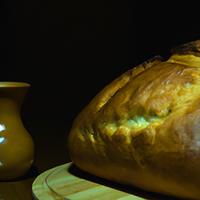
1 serving (60 grams) contains 160 calories, 5.0 grams of protein, 2.0 grams of fat, and 30.0 grams of carbohydrates.

Log this food in SnapCalorie

Nutrition Information
Calories |
640.0 | ||
|---|---|---|---|
% Daily Value* |
|||
| Total Fat | 8.0 g | 10% | |
| Saturated Fat | 2.0 g | 10% | |
| Polyunsaturated Fat | 0 g | ||
| Cholesterol | 0 mg | 0% | |
| Sodium | 1200 mg | 52% | |
| Total Carbohydrates | 120 g | 43% | |
| Dietary Fiber | 4.0 g | 14% | |
| Sugars | 12 g | ||
| protein | 20.0 g | 40% | |
| Vitamin D | 0 mcg | 0% | |
| Calcium | 320.0 mg | 24% | |
| Iron | 6 mg | 33% | |
| Potassium | 200.0 mg | 4% | |
* Percent Daily Values are based on a 2,000 calorie diet. Your daily values may be higher or lower depending on your calorie needs.
Food Attributes
Source of Calories
About White bread from the oven
White bread from the oven is a soft, golden loaf made primarily from refined wheat flour, water, yeast, and a touch of sugar and salt. Originating from European baking traditions, it has become a staple in many cuisines worldwide due to its versatility and mild flavor. While white bread offers quick energy due to its carbohydrate content, it is typically low in fiber and essential nutrients compared to whole grain alternatives, as the refining process removes bran and germ from the wheat. Some white breads are fortified with vitamins and minerals to help address this gap. Its soft texture and neutral taste make it an ideal choice for sandwiches or toast, but moderation is key, as it can contribute to spikes in blood sugar. Pairing it with protein-rich or high-fiber toppings can enhance its nutritional value and make it a more balanced component of a meal.



